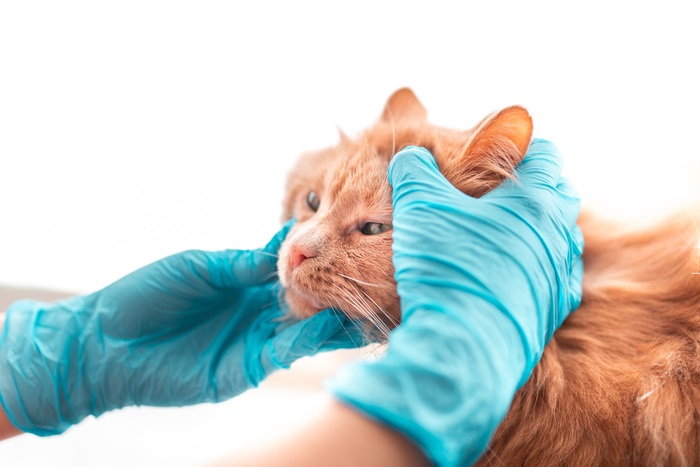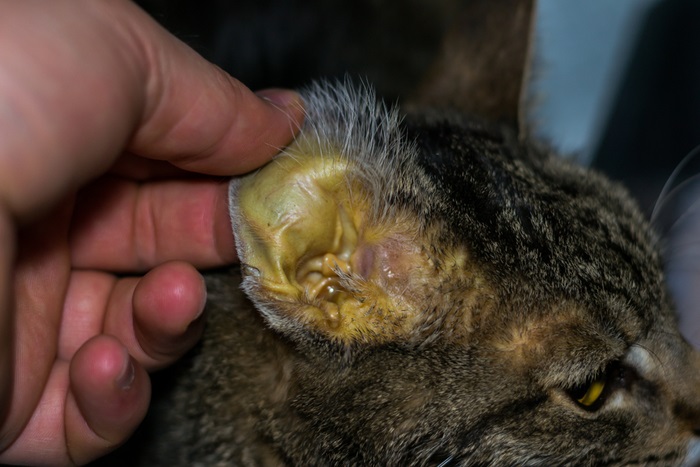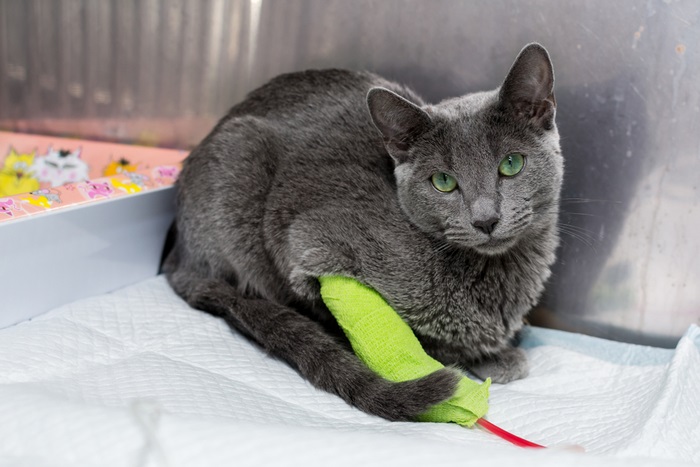
Anemia is the term for a decrease in the body’s circulating red blood cells (RBCs). Depending how low the RBC count goes, this may cause anything from mild symptoms to a life-threatening emergency.
In cats, there are many different causes of anemia—in this article, we’ll cover some of the most common conditions and how they are diagnosed and treated.
What Is Anemia?
Anemia is a term that means a decrease in red blood cells (RBCs), which may be mild, moderate, or severe. It’s caused by an underlying disease, injury, infection, or toxin.
Red blood cells are crucial to the body because their hemoglobin allows them to carry and transport oxygen to all the body’s tissues. As such, if RBC counts get too low, anemia is life-threatening because the body would not receive the oxygen it needs.
RBCs only live for about two months, so the body regularly produces a new supply. The demand for new red blood cells is even higher during anemia.
Anemia is classified as either “regenerative,” meaning the body is trying to produce more RBCs to replace the ones that were lost or damaged, or “non-regenerative,” meaning the body is not producing new RBCs the way it should. This classification helps determine prognosis and treatment.
Causes of Anemia in Cats
Anemia in cats may come about in three ways: by blood loss, by a problem with RBC production, or by conditions in which RBCs are destroyed. Sometimes, more than one of these factors is involved.
Common causes of anemia in cats include:
- Blood loss due to internal or external bleeding.
- Auto-immune conditions where the immune system destroys its own RBCs.
- Severe flea infestations.
- Toxin ingestion. Examples include rat poison, zinc, lead, acetaminophen (Tylenol), and onions.
- Certain infections, such as feline leukemia virus (FeLV) and feline immunodeficiency virus (FIV).
- Blood parasites (many of which are carried by fleas or ticks).
- Stomach ulcers or bleeding in the intestines caused by intestinal parasites, certain medications, or inflammatory bowel disease.
- Chronic kidney disease.
- Other chronic diseases.
- Blood clotting disorders.
- Certain cancers, especially lymphoma and leukemia.
Anemia may affect any cat, although specific underlying causes are more common depending on a cat’s age or lifestyle. For example, fleas and other parasites are most likely to cause anemia in kittens. And anemia of chronic disease (where the body doesn’t produce enough RBCs anymore) is more likely in older cats.
Also, going outdoors puts cats at an increased risk of anemia due to trauma/injuries, parasites, and infections.
Symptoms of Anemia in Cats

Anemia causes a wide variety of symptoms. The pictured cat shows signs of jaundice, which occurs in very severe cases of anemia. Usually, this is only seen with sudden rupture (hemolysis) of large numbers of RBCs.
If the anemia is mild, a cat might not show any obvious symptoms—especially if the anemia is chronic and their body has had a chance to adjust and cope. Or they may show some of the milder symptoms listed below.
With moderate anemia, symptoms are often “non-specific,” meaning they could be due to a number of different diseases and don’t specifically point to anemia. Common symptoms include:
- Lethargy
- Exercise intolerance or lack of interest in play
- Decreased appetite
- Personality changes, such as hiding more often
- Pale gums
- Increased heart rate or breathing rate
- Blood in the urine or stool
As anemia progresses and becomes severe, a cat might show these symptoms:
- Weakness or severe lethargy.
- Very pale or white gums.
- Jaundice (yellow tint to the gums, skin, and whites of the eyes). Usually, this is only seen with sudden rupture (hemolysis) of large numbers of RBCs.
- Collapse.
- Trouble breathing.
- Open-mouth breathing.
- Death.
Additionally, a cat may experience symptoms related to the underlying disease that caused anemia. Common examples include vomiting, diarrhea, weight loss, increased urination, and drinking, or a fever.
Diagnosis of Anemia in Cats
A CBC (complete blood count) provides not only a red blood cell count, but also counts of white blood cells and platelets (clotting cells). This can be done automatically by a machine, or by hand using a microscope—or sometimes both.
Looking at a blood smear under a microscope also provides information about RBC size and appearance (which helps determine if the anemia is regenerative or non-regenerative) and allows visualization of blood cell parasites.
Another common test—called PCV (packed cell volume) or hematocrit—measures RBCs as a percentage of total blood volume. This test can be done in a matter of minutes and only requires a small quantity of blood. For that reason, it’s helpful when results are needed quickly, or when frequent RBC checks are required to monitor progress during treatment.
A normal PCV range for an adult cat is 25-45%. Readings below 25% indicate anemia, and below 15% is considered severe anemia.
It’s also important to diagnose the underlying disease that caused the anemia because addressing the underlying cause is a key component of anemia treatment.
A veterinarian may use the following methods to determine the underlying cause:
- A complete history, including information about how a cat has been acting at home, whether a cat goes outdoors, and possible toxin exposures.
- A physical examination, which evaluates a cat’s overall health and exposes signs of anemia (for example, a heart murmur, pale gums, low blood pressure, enlarged lymph nodes, or jaundice) and underlying illness.
- Blood tests and a urinalysis to evaluate blood cell count, organ function, blood sugar, electrolyte balance, certain hormones, blood clotting times, and more, depending on the specific test(s) ordered.
- Fecal exam for parasites.
- Infectious disease testing (especially for FeLV and FIV).
- If indicated, additional tests such as x-rays, ultrasound, or bone marrow biopsies to diagnose specific medical conditions.
Your vet may start with just a couple of tests, or they may recommend a full health workup. The diagnostic plan depends on your cat’s medical history, the severity of their anemia, other symptoms, and the suspected underlying cause.
Treatment of Anemia in Cats

In severe cases of anemia in cats, a blood transfusion is required. Fortunately, most anemic cats do not require this treatment and can recover after treatment of the anemia’s underlying cause.
If anemia is severe enough to be life-threatening, a blood transfusion is needed. This may save a cat’s life, but unfortunately, a blood transfusion is only a temporary fix. If the underlying condition isn’t addressed, the anemia will return.
Fortunately, the vast majority of anemic cats do not need blood transfusions. Instead, your veterinarian will likely start with a medical workup (as described above) to determine the underlying cause.
Treatment varies depending on the diagnosis. For example, cats with traumatic injuries may need surgery or stitches, while cats with fleas need flea treatment. And cats with chronic kidney disease may need a medication that helps boost production of red blood cells, in addition to supportive care and a special diet for their kidneys.
Very ill pets may require hospitalization until they are stable and feeling better, regardless of cause.
If anemia is due to something that cannot be cured, the goal of treatment may be to provide a good quality of life for as long as possible.
Medication
Medications vary depending on the underlying cause of the anemia. Common examples include:
- Parasite treatment.
- Infectious disease treatment.
- Immunosuppressive drugs (corticosteroids and other medications) for auto-immune disease.
- Erythropoietin supplement for chronic kidney disease (this hormone helps with RBC production).
- Medicines to soothe and protect the stomach and intestines if they are bleeding.
- Chemotherapy for cancer.
Additionally, many cats need supportive care regardless of the cause of anemia. For example, if a cat isn’t eating or drinking due to not feeling well, they may need fluid therapy and appetite stimulants. These things don’t treat anemia, but they allow a cat to feel better and avoid complications caused by not eating and drinking.
Prognosis for Anemia in Cats
The prognosis for anemia varies depending on the underlying cause.
In some cases, the disease is curable and an affected cat will go back to their normal life after treatment. This would be the best-case scenario.
In other cases, the underlying illness is not curable. In the worst case, some conditions are fatal in days or weeks, even with treatment. Other conditions can be managed over the long-term, allowing a cat to live happily for years.
Conclusion
Anemia is a decrease in red blood cells. It’s relatively common in cats, and it’s caused by an underlying medical condition, infection, or toxin. The specific cause of the anemia determines prognosis and treatment. Early diagnosis of anemia is best, as the condition may become life-threatening if severe.







